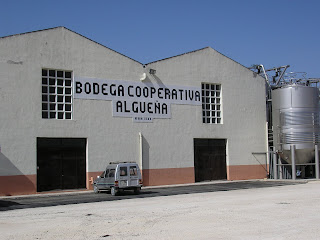The Countryside around Alicante - Part Two: Alguena's Wine Cooperative and Caves
My first stop while touring the Alicante countryside with Mireia Aldeguer of Mandarinablue Travel Experience was the cooperative winery in Alguena, a small village north of Alicante.
Bodega Cooperativa de Alguena
In 1974, local farmers banded together to form the cooperative in order to purchase modern equipment that they could not afford individually. Cooperative wineries face some real challenges. They need to be able to handle large quantities of grapes, and the quality of an individual wine carries less weight than the success of the cooperative as a whole. For example, farmers may be asked to delay harvesting their grapes until the cooperative is ready to accept them.
When the grapes arrive at the cooperative, they are weighed and special equipment measures and provides a printout of the quality and sugar content of the grapes (a large dipstick that measures the quality at all levels). The crushed grapes then move through an overhead pipe into large metal tanks to begin the fermentation process.
I was surprised to discover that the tanks for preparing and aging the wine are located in open areas with no roof. We wouldn’t see this in Canada, but Spanish wineries are often dealing with huge quantities of wine. You’ll notice bands around many of the tanks where cold water circulates to control the temperature.
In the past, the cooperative stored its wine in cement tanks and in large vats under the floor. These were abandoned a number of years ago as research appeared to indicate that concrete tanks allowed for too much oxidation, and that the high humidity in the room wasn’t good for the wine. Several of the Jumilla wineries that I visited use concrete tanks.
Photo of Mireia and Manolo:
Alguena’s Fondillon
The Bodega Cooperative de Alguena makes white, rose and red wines (both joven – young – and crianza – aged), organic wines, and a dessert wine called Fondonet. They are also extremely proud to be one of only 11 wineries in the world to make Fondillon wine.
John Maher of Wines of Valencia provides the following description of Fondillon in a blog post for Catavino:
“So, what is Fondillón? In a nutshell, it is an unfortified, semi-sweet, Monastrell-based “vino rancio” (a style of wine obtained by means of intentional oxidation, or maderization, generally achieved by prolonged periods of ageing in wood or exposure to heat), made from grapes which are left to overripen on the vine before fermentation, resulting in a sweet wine that is very high in alcohol (the finished product comes in at 16-18% ABV). It is then aged in giant wooden barrels for no less than eight years and often more than twenty. The process slowly oxidizes the wine, adding complexity and refinement. The original brilliant red turns slowly to amber until the result is not unlike its fellow “vinos nobles” of Madeira or Sherry in colour and style, so that it is hard to believe that this wine is not fortified and is made solely from red Monastrell grapes. In the words of the Wine Advocate: “Dark amber/brown in color, it has aromas reminiscent of an Amontillado sherry including almonds, ginger, dates, and assorted dried dark fruits. It finishes sherry-like but without the alcohol and the bite. There is nothing else quite like this uniquely styled dry wine.”
The cooperative ages its Fondillon for extended periods, and their collection includes wine from 1955 and 1980. Fresh wine is added to the barrels every year to compensate for evaporation and to refresh the wine.
Alguena’s Cave Houses
Many years ago, as shepherds led their flocks to and from the mountain pastures, they would stop and rest at the spot now known as Alguena. Over time, the shepherds improved their temporary accommodations by hollowing out caves in the hills. Many of these cave homes still exist, although they have been improved so much that you would not know that they are caves by looking at them from the outside.
One of Manolo’s friends has a beautifully renovated cave home and he showed us around. The temperature is stable all year round (21-22 degrees). The house had an internal chimney/skylight that circulated air and provided extra light. There was also a ladder down to a wine storage area in the basement.
The municipality hopes to develop an abandoned cave and turn it into a museum. We explored the cave, finding everything a self-sufficient family would need – hearth, bread oven, stable for the animals and a bodega to make wine.
Thank You
I am very grateful to all of the people who went out of their way to give me such an interesting and educational look at wine-making and life in the Alicante region.
It was such a pleasure to meet and talk with Primitivo, Paco and Manolo from the Bodega Cooperativa de Alguena. Thank you for talking slowly and for answering all my many questions in stumbling Spanish, and for being so generous with your wine.
My thanks to Carmelo and David for showing me the cave houses.
And, last but certainly not least, a huge vote of thanks to Mireia Aldeguer. It was a delight getting to know you, and I hope that Mandarinablue is hugely successful.









Comments